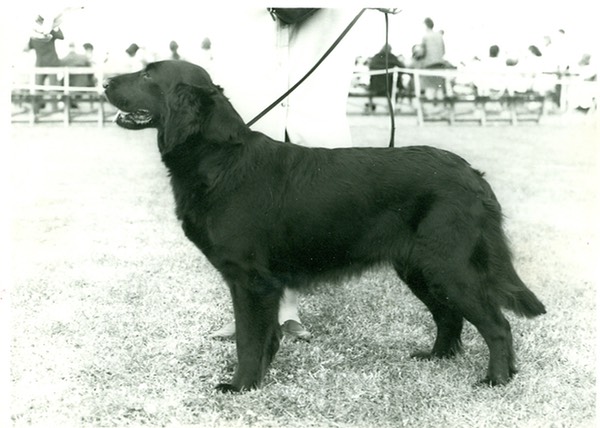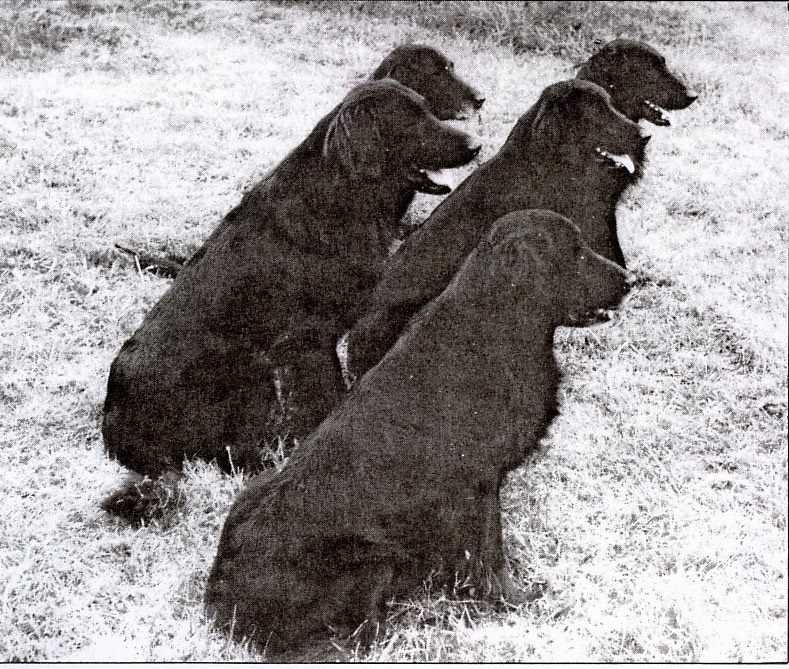By Ingemar Borelius
Amelia Jessel’s (Collyers) Flatcoat bitch Werrion Redwing of Collyers (Ch Wizardwood Sandpiper x Collyers Juno), called Noonie, was the seventh Flatcoat ever to gain the prestigious Brittish Field Trial Champion title in 1979. An achievement shared with the Dual Champions Grouse of Riverside (born 1903), Toby of Riverside (born 1919) and FT Champions Elwy Mary (born 1928), Windle Popular (born 1931), Hartshorn Sorrel (born 1962), Nesfield Michael (born 1965) and Shirlett Sweetheart (born 1997).
Many breeders have tried and a couple of those have been very close but to reach the target and beat the best working Labradors and Goldens in the hardest possible competition is the greatest sign of excellens for a British Flatcoated Retriever handler. The greatness of their achievement is emphasised by the fact that Noonies career took place in the southern England and in the midlands where competition is fierce between the very best Labrador and Golden trainers, entering dogs bred from the very best top performers in each generation.The Flatcoat is totally outnumbered by the Labrador and the Golden at British Field Trials and we should also bear in mind the fact that the two big retriever breeds had been fully divided into show and working lines for many decades. The working Flatcoats at that time at least were mixes of show and work oriented blood lines. Most breeders strived to combine show and work capabilities in the same dog, a most difficult task to perform. Noonies father Ch Wizardwood Sandpiper was one of the top winning show Flatcoats in Britain at that time with no merits from the field. But his littermate, the bitch Wizardwood Whimbrel, was a top performer being quite close to Noonie in her list of merits. Although Noonie herself was far from winning any show points the breeding no doubt accentuated her stunning performance.
Amelia Jessel and Ft. Ch. Werrion Redwing of Collyer
The Honorable Mrs Jessel (her elegant title is due to her being the daughter of Robert Oliver Fitzroy, Second Viscount Daventry) was one of the most experienced Flatcoat breeders, with a number of achievements in the field. She had at least two show champions, her foundation bitch Asperula and Collyer's Blakeholme Brewster. She was for many years the secretary of the Flat-Coated Retriever Society and she was a show judge, a panel A-judge at Field Trials and a member of the Kennel Club Field Trial Committee among many other things. She had a small breeding program and like most great Brittish Flatcoat breeders at that time she rarely had more than a few dogs. Although she, being a well mannered lady, wouldn’t upheave her own role it is obvious to anyone her performance is not a result of chance. To give an idea of how a Field Trial Champion career could look like I forwarded a few questions to Jessel about Noonie, asked her to give her views on the working Flatcoat as a Field Trial dog and what Noonies success could mean for the working Flatcoat in Britain.
Mrs Jessel tells:
- Noonie made her Field Trial debute in 1974 when she was 3rd at the Flatcoated Retriever Society's Non-Winners Stake at one and a half years of age. (Non Winner is a class for comparatively unexperienced dogs). The same season, she was 4th in the Southern and Western Counties Non-Winners stake. Her next success appeared in 1976 when she won the Flatcoated Retriever Society (FCRS) Non - winners Stake and later that year she was 3rd at the Midland Gundogs Non - Winner. The following season she won the Flatcoated Retriever Society (FCRS) Open Stake. She settled the battle masterly handling a running duck. The bird had been located far out on a field, on the other side of a wide and watery ditch and I managed to get her out in the area quite easily. She failed to find it during the first two attempts. But when I redirected her for the third time, I saw her lower her nose and follow a trail in the soggy ditch. She soon returned with the living duck to her handler’s great relief.
- The same year she competed successfully in two other Any Variety Open stakes but failed to obtain a price. In the following season, Noonie was third in the International Gundog Leagues 24 dog Open Stake. The event took place on sugar beet, a kind of terrain she wasn’t used to, but she was lucky enough to get marked birds, a task she performed successfully. Later that season Noonie won the Midland Gundog Open stake once again and in addition to that the Flat Coated Retriever Society Open stake. In the last race she was lucky enough to have a try on a winged Pheasant, which she followed until it went down in a rabbit hole. A participant in a Field Trial, competing with a good dog, always appreciates a chance on a winged pheasant. A large, slighly wounded cock pheasant can run a long distance at a very high speed and it requires a very skilled and fast dog to follow it. The importance of a quick retrieve on wounded game is easy to understand. The test is also a very effective control of the dog's mouth, a dog with a hard mouth probably kills the game and makes it unedible. A retrieve on a fast runner in rough cover is often resolving a Trial.
- I entered Noonie at the United Retriever Clubs Open Stake for 24 dogs again in 1979. But she failed on a winged partridge, which spoiled her chances. On working tests (on cold game) she had one 1st, one 4th and four 5th. Although she had some luck when qualifying for her championship title, she is such an outstanding gamefinder making her worthy of the award. She has the style and the courage that is required in a first class Field Trial dog and she is rock steady to shots and game contacts. These are qualities that are a must in a working Retriever competing for the top honours. It’s a thin line between a dog with courage and determination and a dog that is too independent. A dog with drive could very easily get out of hand if it’s given too much freedom and Noonie utilizes any weakness on my part. I have to be very firm with her if she doesn’t immediately react to the whistle, which isn’t always that easy if there is a river between us. I have often brought her with the other dogs on ordinary shots, but she’s only allowed to take selected birds and I will never let her get out of sight if I can stop it. Noonie is working with great courage in dense cover and in strongly flowing icy waters which must be a consequence of her excellent breeding.
- When it comes to Noonie's breeding I can tell you I’m quite familiar with her bitch line being the fifth generation in straight line from my foundation bitch Ch Asperula (Ch Waterboy x Pewcroft Proper, from Read Flowers first litter). Noonie's grandmother Collyers Skeets had the courage to face rough cover, but she wasn’t as biddable as Noonie. Noonie's mother (Collyers Juno) wasn’t as spectacular as Noonie but she had the fast wagging tail, close hunting pattern and the rapid and willing responses that is needed in a Flatcoat being up for competition against the other breeds.
Collyer Skeet

- I'm not sure to what extent my breeding has enabled this and I must admit that my breeding to a quite high degree is made by chance more than being planned. (Most likely it’s a result of an intuitive feeling for the appropriate combinations and a great knowledge of the breed, IB note.) At first it was a very close mating between Collyers Rose and her father Collyers Blakeholme Brewster producing Collyers Skeets. (As far as I could to remember it was an uncontrolled mating according to Jessel). Skeets looked very good but wasn’t biddable enough to compete at the higher levels. Skeets was mated to Tonggreen Starling producing Collyers Juno. We tried to mate Juno to a dog named Diver of Kingston Wood, being a son of Claverdon Comet, but he failed to mate her and I had to make a quick decision about an alternative stud dog. I choose Wizardwood Sandpiper which was a bit too close knowing that Sandpipers sire, Tonggreen Sparrowboy and Tonggreen starling were full brothers. The mating however produced Noonie and once again a more or less unplanned mating proved to be a success.
- Was the good performance the result of the multiple line breeding back to the great worker Waterboy via Woodlark and his son Fenrivers Golden Rod? Or was it a consequence of this and the close line breeding to Brewster, or any other reason? I don’t know, but I hope to establish a bitch line with the potential to compete with the very best working Retrievers. I have recently used Lingwood Medlar on Noonie adding additional bloodlines back to Collyers Blakeholme Brewster.
- One of the main reasons for the Flatcoat failures on Open stake level is the fact that its rarely trained by the professional top handlers. Most of us are amateurs or even beginners but when a talented Flatcoat is trained by a really skilled handler the’ve usually been successful. Harry Wilsons dog Pewcroft Page died early but had great successes during his short career and he had most certainly conquered the FT Championship title if he’d lived longer. Wilson's Int. FT Ch Hartshorn Sorrel, FT Ch Nesfield Michael and Biddy of Claverdon (dying young like Page) are other examples of highly successful dogs. The litter sisters Claverdon Fantasia and Fidelity were trained by one of the greatest Labrador trainers at that time, Frank Clitheroe, and were very successful for a period of time but they were never trialled by Frank.
- It is very difficult to say whether the Flatcoat has gone forward or backward as a gundog in the last decades because relatively few dogs are seen in the field. There is neither a large number of dogs competing at Field Trials at the moment. I think, for my own part that my dogs have improved, and after all, they are the only ones I could have a strong opinion about.
Finally, I asked Amelia about what Noonies success could mean for the working Flatcoat.
- I hope Noonies title could encourage beginners to train and compete with their dogs. Some people give up when they experience the other retriever breeds as superior. But I hope that the FT Champion title will be the indisputable evidence that a Flatcoat could win in the toughest competition. Personally, I feel that Noonies success has improved my confidence making me more relaxed when I handle my dogs and I hope this feeling could be transferred to other Flatcoat owners. Noonie has been watched by many of the top handlers in UK, I have got a lot of compliments for her working qualities and a number of trainers have asked for a pup out of her.
Flatcoats from Kennel Collyer
